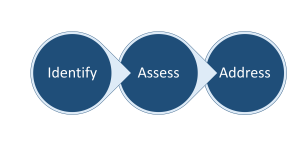5.4 Risk Management Process
In the previous sections, we delved into various facets of risk and risk management, exploring the intricacies of each aspect. As we progress in this section, we aim to bring all those ideas together, providing a holistic view of the risk management process. Risk management is a systematic and structured approach to identify, assess, and address potential threats that could hinder an organization’s ability to achieve its objectives. It encompasses a range of activities, from understanding various risk management frameworks to identifying, measuring, and deciding on tactics to handle these risks.
 It’s imperative to understand that risk management is not a solitary endeavor but a collaborative process. Organizations, especially those operating within supply chains, must approach risk management as a collective effort. When supply chain partners work in silos, the overall system can become inefficient and vulnerable. For instance, if every member in a supply chain independently decides to maintain excess stock as a buffer against disruptions, the cumulative result could be an inflated inventory, tying up resources and increasing costs. Conversely, without collaborative risk assessment, partners might overlook certain risks or fail to recognize interdependencies that could amplify the impact of disruptions. Effective risk management, therefore, requires open communication, shared responsibility, and coordinated strategies across all members of the supply chain.
It’s imperative to understand that risk management is not a solitary endeavor but a collaborative process. Organizations, especially those operating within supply chains, must approach risk management as a collective effort. When supply chain partners work in silos, the overall system can become inefficient and vulnerable. For instance, if every member in a supply chain independently decides to maintain excess stock as a buffer against disruptions, the cumulative result could be an inflated inventory, tying up resources and increasing costs. Conversely, without collaborative risk assessment, partners might overlook certain risks or fail to recognize interdependencies that could amplify the impact of disruptions. Effective risk management, therefore, requires open communication, shared responsibility, and coordinated strategies across all members of the supply chain.
5.4.1 Various Risk Management Frameworks
Navigating the complex landscape of uncertainties requires a structured approach, and risk management frameworks offer just that. These frameworks are meticulously designed blueprints that guide organizations in identifying, assessing, and addressing risks. Let’s delve deeper into three of the most prominent frameworks.
- ISO 31000: The International Organization for Standardization (ISO), a globally recognized body, is the architect behind the ISO 31000 framework. This framework sets out guidelines and principles for creating a comprehensive risk management process. One of the standout principles of ISO 31000 is its emphasis on a tailored approach. This means that risk management strategies and practices should be customized based on an organization’s unique environment. The “external context” refers to the broader social, cultural, political, and economic environment in which the organization operates, while the “internal context” pertains to the organization’s culture, structure, governance, and other internal factors. Given its versatility, ISO 31000 finds its application across a myriad of sectors, from manufacturing and services to public sectors.

- COSO Enterprise Risk Management (ERM) Framework: The Committee of Sponsoring Organizations of the Treadway Commission (COSO) developed the ERM framework. COSO is a joint initiative of five major professional associations dedicated to improving organizational performance and governance. The COSO ERM framework is built on the idea of aligning risk appetite with strategy. It focuses on enhancing risk response decisions and aims to reduce operational surprises and losses. By providing a detailed structure for risk management, it touches upon aspects like risk governance, organizational culture, and data-driven decision-making. Given its robust structure and emphasis on financial transparency, the COSO ERM framework is a favorite in the financial sector, especially among publicly traded companies.

- NIST SP 800-37: Originating from the National Institute of Standards and Technology (NIST), a U.S. federal agency renowned for its work in IT and cybersecurity, the NIST SP 800-37 framework is a beacon in IT risk management. It zeroes in on security and privacy controls for federal information systems. The primary goal is to ensure data integrity, confidentiality, and availability, safeguarding against potential breaches and threats. Given its specialized focus on IT security, organizations, especially those collaborating with federal agencies or aiming to align with federal IT security standards, often turn to the NIST guidelines.

While these three frameworks are pillars in the realm of risk management, the field is vast, with other specialized frameworks like FAIR for cybersecurity risks and the Basel Accords for banking risks. As organizations chart their risk management journey, it’s crucial to explore and select a framework that resonates with their specific needs and industry nuances.
5.4.2 Risk Identification
Risk identification stands as the cornerstone of the risk management process. It’s the act of pinpointing and understanding the myriad threats that could hinder an organization’s objectives. This step is crucial because, without a comprehensive grasp of potential risks, crafting effective management strategies becomes a challenge. Let’s explore the intricacies of this process.
Brainstorming, Surveys, and Beyond: When embarking on the journey of risk identification, organizations often start with brainstorming sessions. These sessions, typically involving a diverse group from various departments, serve as a melting pot of ideas and experiences. The collective insights drawn from these discussions can shed light on risks that might otherwise remain in the shadows. For those interested in a deeper dive into brainstorming and other techniques, Chapter 9 on Demand Forecasting provides additional details, especially on leveraging historical data for demand forecasting and the same concepts can be used for risk identification. For a more structured approach, organizations might turn to surveys. By circulating questionnaires among employees, stakeholders, or even customers, they can amass a wealth of knowledge about perceived risks. Beyond these methods, in-depth interviews and industry report reviews can also be instrumental in unearthing potential threats.
The Dual Nature of Risks – Internal and External: Risks are omnipresent, lurking both within and outside an organization’s boundaries. Internally, risks like employee fraud pose a threat to financial stability and reputation. IT outages, often unforeseen, can disrupt operations, especially in our technology-driven age. Product defects, financial mismanagement, and workplace accidents further exemplify the myriad challenges organizations might face from within.
Externally, the landscape is equally daunting. Economic downturns can squeeze revenues, while regulatory changes can usher in operational hurdles or increased costs. Natural disasters, a force majeure, can wreak havoc on operations and supply chains. The business world is also rife with competitive threats, with innovations or new market entrants potentially eroding an established firm’s market share. Lastly, the intricate web of global supply chains means that disruptions to a single supplier can have cascading effects.

Diving Deeper with FMEA: To navigate this complex landscape of risks, organizations often employ structured methodologies like the Failure Modes and Effects Analysis (FMEA). FMEA delves deep into potential failures, be it in a product or a process, and assesses their potential impacts. By systematically evaluating how something might fail and the repercussions of such failures, organizations can prioritize risks. This is where the concept of Risk Priority Number (RPN), introduced in Section 5.2, comes into play. By quantifying risks, FMEA ensures that organizations address the most pressing threats first, fostering a proactive rather than reactive approach to risk management.
5.4.3 Measuring Risk
Once the potential risks have been identified, the next pivotal step in the risk management process is to measure or quantify these risks. This quantification provides a structured way to prioritize and address risks based on their potential impact on the organization. The primary tool for this quantification, as introduced in Section 5.2.1, is the Risk Priority Number (RPN). The RPN is a numerical representation derived by multiplying three key components: the probability of the risk occurring, the degree of its potential impact, and the ease (or difficulty) of its detection. Each of these components is rated on a scale from 1 to 10, with the resulting RPN providing a comprehensive score for each risk.
By calculating the RPN for every identified risk, organizations can create a ranked list. This list, when sorted in descending order, places the risks with the highest RPN values at the top. These top-ranked risks are the ones that demand immediate attention, as they represent the most significant potential threats to the organization.
In essence, measuring risk using the RPN methodology ensures that organizations focus their resources and efforts on the most pressing risks, enabling them to proactively manage and mitigate potential disruptions.
5.4.4 Risk Tactics
Once risks have been identified and measured, the next step is to determine the most appropriate tactic to manage each one. There are four primary risk management tactics that organizations can employ: Elimination, Mitigation, Transfer, and Acceptance. Each tactic has its own set of implications, both in terms of the cost of the risk and the cost of managing it.
- Elimination: This tactic involves taking steps to completely remove the risk. It’s the most definitive approach but can also be the most costly in terms of resources and effort. For instance, if a manufacturing process has a step that consistently introduces defects, eliminating that step or replacing it with a different method would be an example of this tactic.
- Mitigation: Mitigation doesn’t remove the risk entirely but reduces its impact or likelihood. For example, regular maintenance checks on machinery can reduce the risk of unexpected breakdowns. Training employees on cybersecurity best practices can mitigate the risk of data breaches.
- Transfer: This tactic involves shifting the responsibility or burden of the risk to another party. Common examples include insurance policies or outsourcing certain operations. If a company is concerned about the risk of shipping delays, they might use multiple shipping providers to transfer some of that risk.
- Acceptance: Sometimes, the best approach is to simply accept the risk, especially if the cost of managing it outweighs the potential impact. This is often the case for very low-probability risks or those with minimal potential impact. For instance, a business might accept the risk of a temporary power outage if they operate in an area with a stable power grid.
As we transition from elimination to acceptance, the cost of the risk tends to increase, but the cost of managing the risk decreases. This balance is crucial in determining the most appropriate tactic for each risk.
Referring back to the sorted list from Section 5.4.3, risks at the top, with high RPNs, are inherently more problematic and demand immediate attention. Given their potential impact, organizations should prioritize these risks and, where possible, aim for elimination or at least mitigation. Conversely, risks at the bottom of the list, with lower RPNs, might not warrant significant resources for management. In such cases, acceptance or transfer might be the more pragmatic approach. By aligning risk tactics with the RPN rankings, organizations can ensure a strategic and cost-effective approach to risk management.
5.4.5 Overall Example: Risk Management in Action
To illustrate the risk management process in a real-world context, let’s consider the case of a hypothetical electronics manufacturing company, ElectroTech Inc.

Risk Identification: During a brainstorming session, ElectroTech’s team identified several potential risks. Some of these included:
- Supply chain disruptions due to geopolitical tensions.
- Machinery breakdown leading to production halts.
- Cyberattacks compromising proprietary designs.
- Regulatory changes affecting export procedures.
Measuring Risk: Using the RPN methodology, ElectroTech quantified each risk. The risk of machinery breakdown, for instance, had a high probability of occurrence but a moderate impact and was relatively easy to detect. This gave it an RPN value that placed it near the top of their list. On the other hand, regulatory changes had a lower probability but a high impact and were harder to detect, placing it further down the list.
| Risk | Probability of Risk (1-10) | Degree of Impact (1-10) | Ease of Detection (1-10) | RPN (Calculated) |
| Machinery breakdown | 8 | 7 | 9 | 504 |
| Cyberattacks | 7 | 8 | 6 | 336 |
| Supply chain disruptions | 6 | 8 | 5 | 240 |
| Regulatory changes affecting exports | 4 | 9 | 3 | 108 |
In this table, the risks are sorted based on their RPN values, with the highest RPN at the top. The machinery breakdown risk, with an RPN of 504, is deemed the most critical, followed by cyberattacks, supply chain disruptions, and regulatory changes. This prioritization helps ElectroTech focus its resources and strategies on the most pressing risks first.
Risk Tactics: For the machinery breakdown risk, ElectroTech decided on mitigation. They implemented a rigorous maintenance schedule and invested in training for their technicians. For the cyberattack risk, they chose a combination of mitigation (enhanced cybersecurity measures) and transfer (cyber liability insurance). Given the lower RPN of the regulatory changes risk, they opted for acceptance but kept a close eye on international trade news to stay informed.
A few months later, ElectroTech faced a machinery malfunction. However, thanks to their proactive risk management, the issue was quickly detected and resolved with minimal production downtime. Their cybersecurity measures also successfully thwarted an attempted breach, and the insurance provided an added layer of financial protection.
ElectroTech’s experience underscores the importance of a systematic approach to risk management. By identifying, measuring, and tactically addressing risks, the company not only safeguarded its operations but also gained a competitive edge in the market. Their proactive measures ensured business continuity, bolstered stakeholder confidence, and reinforced their reputation as a reliable electronics manufacturer.